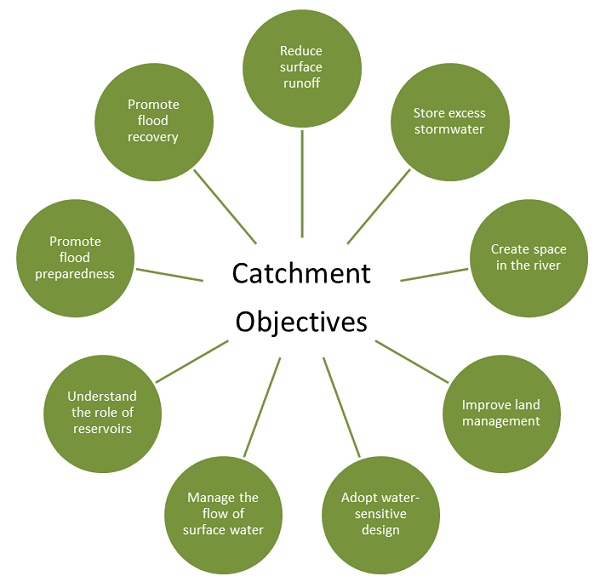EPSRC Studentship
Building a community understanding of flood risk through participatory modelling
Running alongside the Blue-Green Cities project was an EPSRC studentship held by Shaun Maskrey and supervised by Nick Mount and Colin Thorne at the University of Nottingham.
The studentship investigated the potential of different participatory modelling tools to more actively involve local stakeholders in the modelling of flood risk. It had the following five objectives:
- Elicit what participation aims to deliver at different stages of the flood risk modelling process
- Identify the strengths and limitations of different participatory modelling tools
- Develop a methodological approach through which participatory modelling can be delivered
- Trial and evaluate different participatory tools in local flood risk contexts
- Develop a framework against which to evaluate the use of participatory tools
Two case studies, Hebden Bridge, West Yorkshire and Southwell, Nottinghamshire, were selected in which to trial two popular tools: Bayesian networks and system dynamics, respectively. Literature review has revealed that the affordances of these tools are suited to different stages in the flood risk modelling process (Figure 1).
The Hebden Bridge and Southwell case studies in the PhD research space.
The case study in Hebden Bridge ran from late-2013 to mid-2014. It consisted of six workshops attended by a mixture of local stakeholders, including non-expert residents and expert representatives from the Environment Agency, Calderdale Metropolitan Borough Council, The National Trust and others. Through a series of modelling activities, the group co-produced a conceptual model of their understanding of flood risk using Bayesian networks. The network was built around nine key ‘catchment objectives’ identified by participants (Figure 2), and investigated how different interventions might affect their achievement.

Catchment objectives for the Hebden Bridge case study.
Results showed that participants prioritised the social consequences of flood above other effects of flooding, and saw a community stewardship approach to flood resilience as being the favourable route to achieving their objectives, as illustrated in the 'Change Under Each Scenario’ pdf  .
.
A second case study in Southwell ran in 2015. In partnership with Southwell Flood Forum, five workshops uased employ system dynamics as the participatory modelling tool. Southwell is at a much later stage in the flood risk modelling process than Hebden Bridge (Figure 1), with the community focussed on appraising options and designing solutions for reducing flood risk, the funding for which (c. £1.9 million) having recently been secured. The five workshops brought together a group of 15-20 individuals, mainly local residents (both experts and non-experts), with additional representatives from Nottinghamshire County Council, the Environment Agency and Severn Trent Water.
Hebden Bridge e-Bulletins
e-Bulletins provided the stakeholders involved in the Hebden Bridge project with background information and regular updates on progress and future workshops (oldest at top).
 Looking at flood risk differently in Hebden Bridge
Looking at flood risk differently in Hebden Bridge
 The multiple benefits of thinking blue-green in Hebden Bridge
The multiple benefits of thinking blue-green in Hebden Bridge
 A very short introduction to Participatory Modelling
A very short introduction to Participatory Modelling
 A very short introduction to Bayesian networks
A very short introduction to Bayesian networks
 Our Partnership with the Blue-Green Cities project
Our Partnership with the Blue-Green Cities project
 Hot off the press in surface water flooding
Hot off the press in surface water flooding
 Uncertainty
Uncertainty
 Behind the scenes 1: Initial network structure
Behind the scenes 1: Initial network structure
 Risk
Risk
 Mid-project progress report
Mid-project progress report
 Taking a step backwards...to see the bigger picture
Taking a step backwards...to see the bigger picture
 Behind the scenes 2: Merging the Networks
Behind the scenes 2: Merging the Networks
 Hot off the press in uncertainty
Hot off the press in uncertainty
 Behind the scenes 3: Building the model in Netica
Behind the scenes 3: Building the model in Netica
 Future Scenarios
Future Scenarios
 From West Yorkshire to Whitehall
From West Yorkshire to Whitehall
 Portland Revisited
Portland Revisited
 Project Wrap-Up
Project Wrap-Up
Read about Shaun's research in the Hebden Bridge factsheet 
A blog "Upper Calder Valley: Floods" by Jenny Shepherd, local resident of Hebden Bridge, provides details of the activities and discussions in the stakeholder workshops.
Southwell e-Bulletins
 The project in 300 words (December 2014)
The project in 300 words (December 2014)
 What went before - Hebden Bridge (Jan 2015)
What went before - Hebden Bridge (Jan 2015)
 Causal loop diagrams (Feb 2015)
Causal loop diagrams (Feb 2015)
 Thinking about Risk (Feb 2015)
Thinking about Risk (Feb 2015)
 System Dynamics (March 2015)
System Dynamics (March 2015)
 Behind the scenes 1 (March 2015)
Behind the scenes 1 (March 2015)
 Belford Burn (April 2015)
Belford Burn (April 2015)
 Futures (May 2015)
Futures (May 2015)
Read the Southwell factsheet 